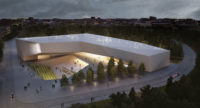Jerusalem, a millennia-old city sacred to Judaism, Christianity, and Islam, is also a growing metropolis and the capital of a modern country. But its population of 720,000, two-thirds Jewish and one-third Palestinian, is deeply divided religiously and politically. Development must accommodate these groups’ conflicting needs—and ubiquitous archaeological remains.

Even a seemingly simple project, such as replacing a temporary pedestrian bridge leading to the sacred Temple Mount, can provoke the threat of Armageddon. In February, just as construction was to begin, archaeological excavations rekindled old rumors that Israelis were endangering the al-Aqsa mosque nearby. Riots forced Mayor Uri Lupoliansky to freeze the project. Although other ancient cities must grapple with archaeological remains, Jerusalem with its development problems is unique—and requires solutions that go beyond architecture.
Typical design issues such as height and material choice often take a back seat to religious and political considerations, says David Kroyanker, a Jerusalem-based architectural historian. He cites the Frank Gehry–designed Museum of Tolerance, part of which is to be built on Muslim graves. Planning began in 2000, but the project is now mired in a lawsuit brought by two Muslim groups. A judge recently ordered an architectural solution. The one that was offered—that part of the museum be cantilevered so that it’s “over, not on” the graves—was deemed “ludicrous” by Muslim objectors. A final ruling could come as early as this summer.
A lack of respect for different cultures’ values often lies at the heart of Jerusalem’s problems. Local architect David Guggenheim observes that the degree to which opposing groups will compromise often depends on the prospects for peace in the region. Currently, these prospects are receding.
Guggenheim echoes many residents who want a greater voice in planning decisions. He adds that completing the long-delayed detailed zoning plans for burgeoning Palestinian neighborhoods—without which the city refuses to issue building permits—could break the vicious cycle of illegal housing construction and demolition.
But instead of finishing these plans, elected officials pursue projects by high-profile architects that they claim will attract tourists and boost the economy in Jerusalem, the poorest of Israel’s cities. Among them are Gehry’s museum and a bridge designed by Santiago Calatrava, currently going up as part of a new light-rail system. Many observers believe politicians’ priorities are misguided.
“Jerusalem is not Bilbao and it doesn’t need additional tourist attractions,” contends Anda Barr, newly elected chairman of the Israel Association of United Architects. “The right way to get good architecture is through international competitions for public buildings, rather than by importing big names.”
There are some glimmers of hope. Mayor Lupoliansky promised that the plans for a new Temple Mount bridge will be subject to public review, and the city is upgrading public housing. For now, though, if anything is certain, it’s that Jerusalem won’t be built in a day.



Post a comment to this article
Report Abusive Comment